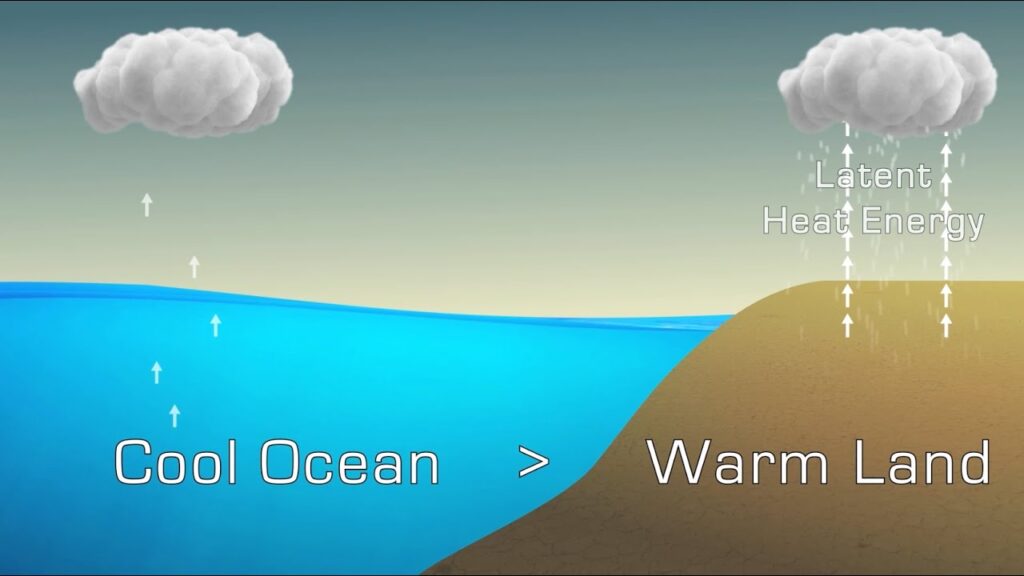Indian Ocean Warming: Future heat content increases might be as much as adding the energy of one Hiroshima atomic bomb detonation per second for ten years.
If greenhouse gases (GHGs) are not rapidly decreased, the Indian Ocean may continue to warm at an unprecedented and accelerated rate for the rest of the century. According to a recent study that was published in the journal Science Direct, the Indian Ocean may warm by 1.7–3.8 degrees Celsius every century between 2020 and 2100.
This might have major repercussions on biodiversity, particularly on coral reefs, as well as broad socioeconomic effects.
Lead author of the study and climate scientist at Indian Institute of Tropical Meteorology Roxy Mathew Koll told Down To Earth that “the future increase in heat content is equivalent to adding the energy of one Hiroshima atomic bomb detonation every second, all day, every day, for a decade.”

The southwest monsoon season, which produces roughly 70% of India’s yearly rainfall and influences rainfall patterns in other South Asian nations, is greatly impacted by this warming of the ocean’s surface as well as the heat accumulated in the first 2,000 meters below the surface.
According to the study, the heat content of the first 2,000 meters below the ocean’s surface is currently rising at a pace of 4.5 petajoules per decade, while future forecasts show a sharp increase to 16–22 petajoules per decade.
Dalvir Goldy News: Former MLA Dalvir Goldy hinted at leaving the Congress party.
This warming could also lead to more frequent and intense extreme weather events, such as tropical cyclones and floods, as well as a rise in sea levels due to thermal expansion.
The study also examined the Indian Ocean’s warming over the past century, finding that the ocean basin heated at a rate of 1.2°C per century between 1950 and 2020.
The northwestern parts of the Indian Ocean, including the Arabian Sea, experienced the most significant warming, while the southeastern parts of the ocean, off the coasts of Sumatra and Java, experienced the least warming.
The study also discovered that the seasonal cycle of surface temperatures has shifted and might shift further due to warming. Between 1980 and 2020, the maximum sea surface temperatures (SST) across the Indian Ocean generally stayed below 28°C (ranging from 26-28°C).
Nothing Phone 2a launched In India: Check, Price, Feature, Offer Here.
If GHGs are emitted at current levels, the minimum SSTs in the Indian Ocean could exceed 28°C (28.5-30.7°C) all year round by the end of the 21st century, according to the study. Generally, SSTs above 28°C are conducive to the formation of tropical cyclones and extremely heavy rainfall.
Heavy rainfall events and extremely severe cyclones have already become more frequent since the 1950s and are projected to increase further with rising ocean temperatures, according to Koll.
The increased ocean heat would also cause thermal expansion in the Indian Ocean, resulting in rising sea levels in the 40 countries that border it. Thermal expansion of water accounts for more than half of the sea level rise in the ocean, exceeding the contribution from glacier and sea-ice melting, Koll said.
Other natural climatic phenomena, such as the Indian Ocean Dipole (IOD), are also expected to change due to the warming of the Indian Ocean. The positive and negative phases of the IOD influence rainfall during the southwest monsoon and affect the formation of tropical cyclones.
IPL 2024: Kavya Maran’s displeasure with SRH’s poor fielding against CSK becomes widely shared.
In the positive phase of the IOD, when the western parts of the Indian Ocean are warmer than the eastern parts, monsoon rainfall generally increases across many regions in India and the rest of South Asia.
In the negative phase, when the western parts of the ocean are cooler than the eastern parts, less than normal rainfall is observed during the post-monsoon period in northwestern India.
The study predicted that the frequency of extreme IOD events may increase by 66 percent, while the frequency of moderate events is projected to decrease by 52 percent by the end of the century.
The authors of the study also describe a concerning outlook for the Indian Ocean in terms of marine heatwaves, which are events when large areas of the ocean become much warmer than usual and remain so for extended periods.

The number of days with marine heatwaves is expected to increase from 20 to 220-250 days a year, according to the study. This would mean that most of the Indian Ocean could be in a near-permanent state of marine heatwave conditions.
Marine heatwaves lead to habitat destruction through coral bleaching, seagrass loss, and the degradation of kelp forests, adversely affecting the fisheries sector. They also result in the rapid intensification of cyclones, where a cyclone can intensify from a depression to a severe category within a few hours, according to the study.
“The Indian Ocean, a climate change hotspot, faces rapid and strong increases in marine heatwave frequency and intensity unless global CO2 emissions are substantially cut,” said Thomas Frölicher, a climate scientist at the University of Bern, Switzerland, and one of the authors of the study.
The bio-geochemical characteristics of the Indian Ocean are also expected to change due to the warming. For instance, the pH levels of the ocean’s waters are projected to decrease from about 8.1 currently to 7.7 by the end of the century.
“The projected changes in pH may be detrimental to the marine ecosystem since many marine organisms — particularly corals and organisms that depend on calcification to build and maintain their shells — are sensitive to the change in ocean acidity,” said Koll.
“The change may be easier to fathom when we realize that a 0.1 fall in human blood pH can result in rather profound health consequences and multiple-organ failure,” he added.
The productivity and surface levels of chlorophyll are also expected to decline by 2100, with the greatest reduction in the western Arabian Sea, where levels could fall by 8-10 percent from their current state.
“It is crucial to recognize that the impacts of these changes are not distant concerns for our grandchildren and future generations alone. As the current generation, we are already witnessing the repercussions firsthand,” said Koll.
Watch the video to see Kavya Maran response to Pat Cummins missing Ruturaj Gaikwad’s runout.
The study recommended a multifaceted approach to address the imminent challenges in the Indian Ocean. Reducing GHG emissions and building climate-resilient infrastructure are the most effective strategies to mitigate the current and future impacts of warming.
Concurrently, conserving marine ecosystems through sustainable practices and improving forecasting capabilities can strengthen the region’s resilience to extreme weather events. Additionally, promoting adaptive agriculture and encouraging international collaboration are essential for ensuring food security and preserving biodiversity, according to the study.
FAQ’s
What is the Indian Ocean effect?
That means the surface waters in the Indian Ocean get pushed from west to east.
What are 5 facts about the Indian Ocean?
Indian Ocean Facts
- It comprises 20% of the world’s water surface.
- It consists of 57 islands and is bordered by 16 African countries and 18 Asian countries in total.
- Its highest point is at sea level.
- It is the warmest ocean of all of the five oceans in the world.
Who is affected by warming oceans?
Marine life will suffer the most due to unprecedented ocean warming. Fish species now migrate north to find cooler temperatures and food sources, impacting communities and economies that depend on fishing.
How to reduce ocean warming?
Solutions For Ocean Warming
- Reduce greenhouse gas emissions (GHGs) …
- Ocean Alkalinization. …
- Strengthening coastal ecosystems. …
- Monitoring human activities. …
- Enhancing scientific research. …
- Solar Radiation Management (SRM) …
- Adoption of green tech. …
- Relocation and Reef Restoration.















Reader Interactions